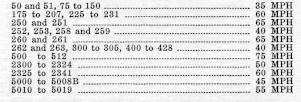|
|
|
SI_Page_16 Trains or engines thru No. 15 turnouts at 25 MPH: Wenatchee, east and west crossover switch west end of yard. Merritt, east and west siding switch. Skykomish, west siding switch. Baring, east and west siding switch. Monroe, east and west siding switch. Snohomish, east and west siding switch. Everett Jct., junction switch end of double track. Interbay, end of double track west end of yard. Interbay, yard lead switch near 23d Ave. overhead bridge. Trains or engines thru all other turnouts.....15 MPH Between Ballard and Seattle, Streamliners will be governed by speed restriction as indicated under Item 2, First Subdivision. 3.....MOVEMENT OF ENGINES DEAD IN TRAINS. Class O and larger engines will be placed not to exceed 15 cars behind road engine. In electrified zone only class R engine will be handled on head end, all others near rear. Class F-8 and smaller engines will be placed next ahead of caboose. Diesel engines 2300-2341 must be handled on rear of train. Not less than five cars will be placed between all engines. Trains handling steam engines dead in train with side rods on both sides will not exceed 40 MPH; and without side rods will not exceed 10 MPH. Trains handling Electric, Diesel and Gas Electric engines dead in train will not exceed following speeds:  4.....Under Rule 2 of the Consolidated Code of Operating Rules, watches that have been examined and certified to by a designated inspector must be used by train dispatchers and yardmen. 5.....The following Consolidated Code of Operating Rules and definitions do not apply to Great Northern or Northern Pacific employes, unless they work in joint territory where such rules are in effect: 10 f 14 t, u, v, w 210 217 225 251-264 incl. 300-373 (A) incl. S-509 (A) 606, a, b, c, d 636 Manual Block System Block Stations Cab Signals 6(a).....Not more than one employe will ride on leading footboard of engine, then outside of rail, preferably on engineer's side. 6(b).....Employes are prohibited from riding on pilot or pilot beam of engine, or on footboard between engine and cars when cars are being pulled, shoved, switched, or while coupling is being made. Streamliner cars are equipped with diaphragm full width of the car. There is no clearance between the ends of these cars when coupled. Employes must stay entirely in the clear while these cars are being switched or coupled. 6(c).....When adjustment is necessary to drawbar, knuckle pin, or locking block, prior to making coupling, or when coupling fails, engines or cars must be separated, not less than 10 feet and action taken to prevent movement before going between cars. 6(d).....Where helper engine is used behind caboose helping train, helper pilot will ride engine, and engine will be uncoupled by trainman from caboose platform. 6(e).....When heading out of sidings, freight trains with helper engine behind caboose, must regulate speed so that rear trainman can line switch and get on caboose instead of tank of helper engine. This as a matter of safety because employes are prohibited from using running board of engine or passing from front of engine to caboose while train is in motion. 6(f).....Employes are forbidden to stand with feet resting upon car trucks, truck frame, or oil box while car is in motion. |